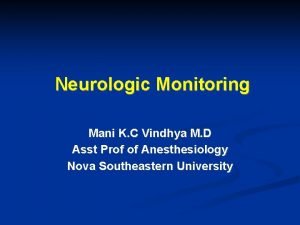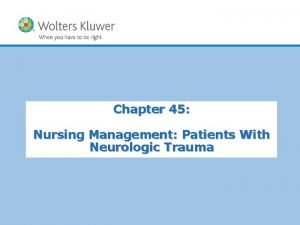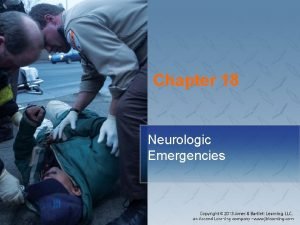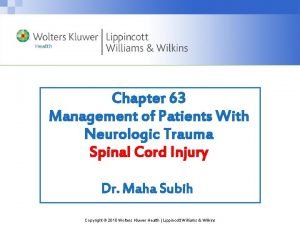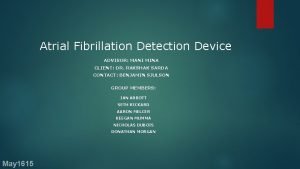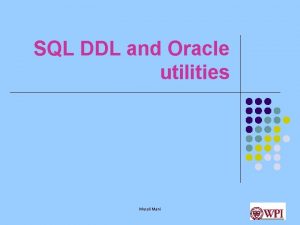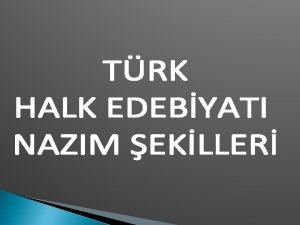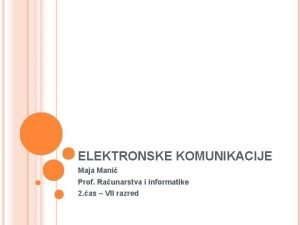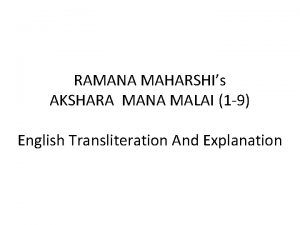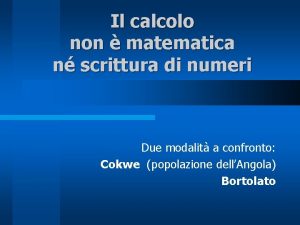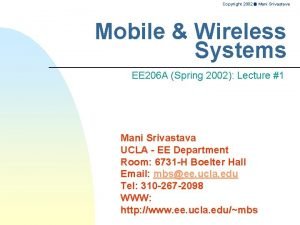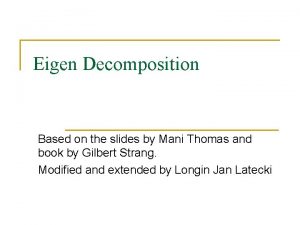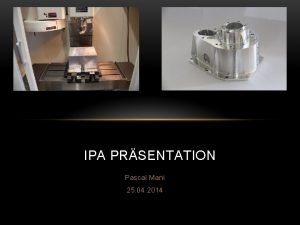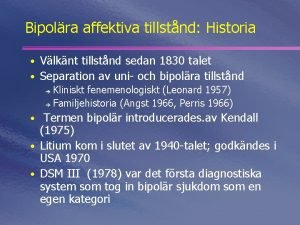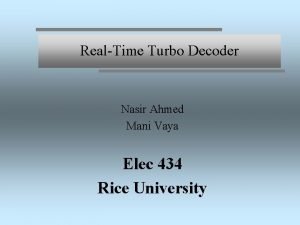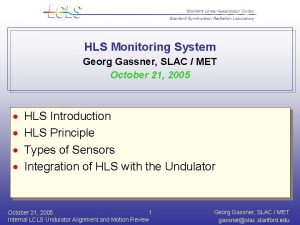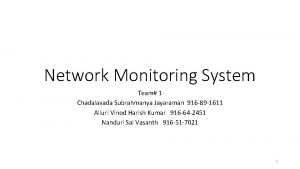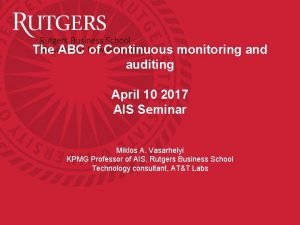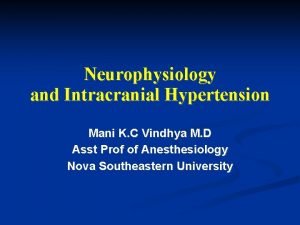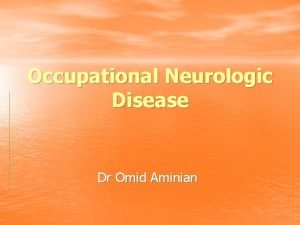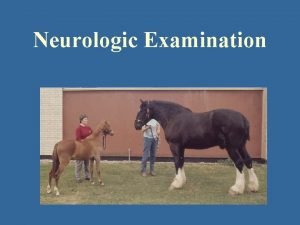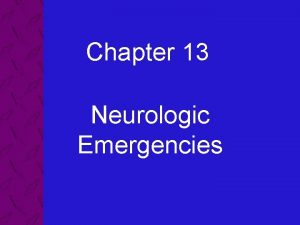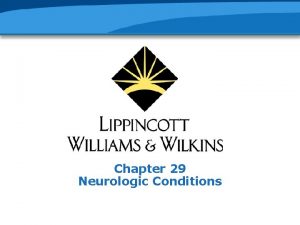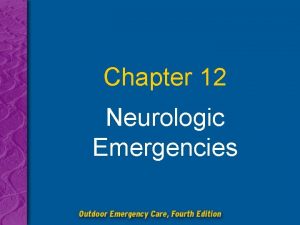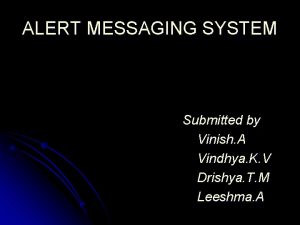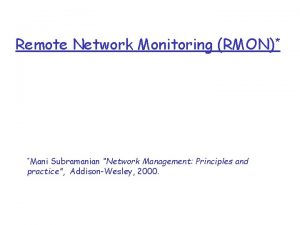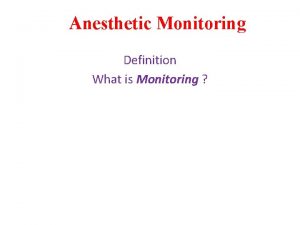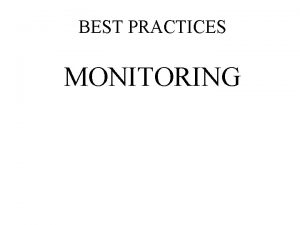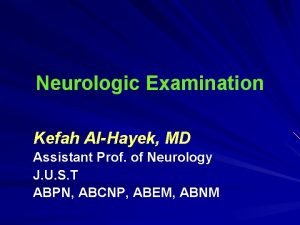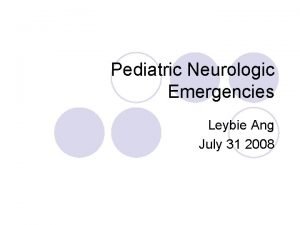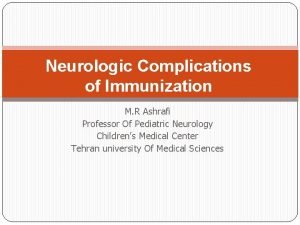Neurologic Monitoring Mani K C Vindhya M D








































- Slides: 40

Neurologic Monitoring Mani K. C Vindhya M. D Asst Prof of Anesthesiology Nova Southeastern University

Introduction to EEG Interpretation Basic EEG Interpretation. You basically study an EEG for three things -- frequency, amplitude, and symmetry. 1. Frequency. The electrical waveform of the EEG is divided into sine waves of specific frequencies (cycles/sec or Hertz = Hz). The mnemonic I use to remember the frequencies is: DON'T TOUCH A BRAIN, or DON'T TOUCH A BAGEL – D. T. A. B. Delta waves = 0 to 3 Hz -- Deep Anesthesia or Deep "Stage 4" Sleep Theta waves = 4 to 7 Hz -- general anesthesia and hyperventilation Alpha waves = 8 to 13 Hz -- Awake but relaxed, eyes closed Beta waves = 14 to 30 Hz -- awake and alert (eyes open) or excitement phase of anesthesia


Amplitude -- measured in microvolts (u. V). Sometimes amplitude is expressed as power, which is the amplitude squared, (u. V)2. Low amplitude = < 20 microvolts (u. V) Medium amplitude = 20 to 50 u. V High amplitude = > 50 u. V Symmetry. Do the EEG waveforms look the same on each side?


Summary of Factors Affecting the EEG Increased frequency Barbiturates, benzodiazepines, etomidate, propofol (low dose) Inhalational agents (< 1 MAC) Nitrous oxide 30 -70% (acts on NMDA receptors) Ketamine (acts on NMDA receptors) Hypoxia (initially) Hypercarbia (mild) Seizures Decreased frequency/increased amplitude Barbiturates, etomidate, propofol (moderate dose) Opioids Inhalation agents (> 1 MAC) Hypoxia (mild) Hypocarbia (moderate to extreme) Hypothermia

Decreased frequency, decreased amplitude Barbiturates (high dose) Hypoxia (mild) Hypercarbia (severe) Hypothermia (< 35 o. C) Electrical silence Barbiturates (coma dose) Etomidate, propofol (high dose) Isoflurane, desflurane, sevoflurane (2 MAC) Hypoxia (severe) Hypothermia (< 15 -20 o. C) Brain death

Effects of anesthetics on the EEG: 1. Can be expressed as graphs showing frequency on the x-axis and amplitude on the y-axis 2. Awake individual -- alpha and beta activity, about 20 u. V amplitude

Fentanyl and other narcotics -- classically produce high amplitude, low frequency delta wave activity

Inhalational anesthetics: Low concentrations -- increase frequency & amplitude, or "EEG activation" Higher concentrations -- high amplitude theta acticity Isoflurane -- starts with "iso" because it produces an isoelectric "flat" EEG at > 2 MAC (This is true for sevoflurane and desflurane, too) Enflurane -- starts with an "E" because it is Epileptogenic, especially with along with hyperventilation and hypocapnia. Seizures markedly increase frequency. Sevoflurane – can also cause “seizure” activity (> 1. 5 MAC)

Sodium pentothal and other barbiturates produce a whole spectrum of different effects, depending on the dose: EEG activation -- in low doses Barbiturate spindles Slow delta wave activity Burst suppression -- defined as an isoelectric EEG with < 6 bursts of EEG activity per minute = the desired endpoint for barbiturate coma (cerebral protection) Isoelectric or "flat" EEG

Other intravenous anesthetics: • a. Many of the other IV anesthetics suppress the EEG, as does sodium pentothal: – Propofol – Etomidate – Ketamine • b. These IV anesthetics may show seizure-like (spike and wave) activity on the EEG.

To avoid peri-operative drug-induced seizures in epileptic patients: Continue anti-convulsant therapy. Consult with patient’s neurologist to discuss management. Avoid etomidate. Do not use sevoflurane routinely. Limit maximum concentration to < 1. 5 MAC.

Effects of hypoxia on the EEG:

Effects of hypocarbia on the EEG (similar to mild hypoxia):

Effects of Anesthetics and Hypoxia on the EEG Hypoxia and many anesthetics: IV anesthetics (pentothal, propofol, etomidate) Inhaled anesthetics (isoflurane, sevoflurane, desflurane) Share similar effects on EEG: High frequency, high amplitude Low frequency, high amplitude EEG burst suppression Isoelectric EEG

Types of processed EEGs Processed EEGs use power spectrum analysis to break the EEG down into its component frequencies.

Bispectral index (BIS) is generated in part by power spectrum analysis. Compressed Spectral Array (CSA) expresses EEG as “hills and valleys. ” Frequency – on the x-axis Amplitude – shown as height of the hill, or y-axis Time. The “hills and valleys” are stacked over time on a 3 -D zaxis.

Example of effect of carotid occlusion on CSA: Arrow marks time of left carotid artery occlusion

Density Spectral Array (DSA) Similar to CSA Expresses “hills and valleys” as “dark and light. ”

Lifescan (Periodic Analysis) – expressed EEG activity as “telephone poles”

Introduction to Evoked Potentials – Sensory evoked potentials (or responses) • Brainstem auditory evoked responses • Somatosensory evoked potentials • Visual evoked responses

Brainstem auditory evoked potentials or responses (BAEP's or BAER’s) Specialized form of EEG monitoring Background EEG activity is electronically subtracted out. The EEG waveform evoked by auditory stimulus (clicking in ear) remains.

Shape of a typical BAEP = seven peaks Latency = time to first peak (usually 2 msec) Amplitude = height of the peaks

The seven peaks of the BAEP are believed to correspond to passage of a stimulus through "generators" in the auditory nerve, brainstem and cortex.

What do we look for during surgery? Mainly two things: Increase in latency (> 10%) Decrease in amplitude (<50%) These two changes could be indicative of impending injury or ischemia in the BAEP pathway

BAER's are barely affected by anesthetics: 1. No anesthetic drug produces a change in BAER’s that could be mistaken for a surgically induced change. 2. Etomidate decreases amplitude and increases latency (but this is not clinically significant).

Somatosensory evoked potentials Upper extremity: Median nerve SSEP has “M” shape

Lower extremity: Posterior tibial nerve SSEP has “W” shape

What do we look for during surgery? Decrease in SSEP amplitude Increase in latency (time to first peak or dip) Six I’s that inhibit SSEP’s: Inhaled anesthetics, including isoflurane N 2 O doesn’t decrease amplitude alone, but has a synergistic effect with volatile agents. IV agents, but to a lesser extent than inhaled anesthetics Etomidate = the exception; it increases SSEP amplitude Ischemia/hypoxia Injury, to the spinal cord or anywhere in SSEP pathway “Ice cold” temperatures (< 34. 5 o. C) Incompetence (observer foul-ups)

Summary of effects of anesthetics on SSEP’s: Inhaled anesthetics – dose-related decrease in amplitude and increase in latency Use less than 1 MAC volatile agent Nitrous oxide – profound depressant effect on SSEPs, especially when used in combination with volatile agent

Intravenous agents a. Propofol and thiopental Small decrease in amplitude and increase in latency Propofol is commonly used for TIVA (total IV anesthetic technique) Opioids – negligible effects on SSEPs Ketamine and etomidate – increase SSEP amplitude (Etomidate is exceptional. It increases SSEP amplitude but decreases BAEP amplitude. ) Anesthesia for SSEP’s (progression from routine to desperate) Volatile agent / N 2 O / narcotic Volatile agent / propofol / narcotic TIVA: total IV anesthetic with propofol and narcotic Etomidate / narcotic (really desperate) Increases amplitude Adrenocortical suppression with etomidate

Other Evoked Potentials Visual evoked potentials M shape Long latency Sensitive to all anesthetics except opiates

Motor evoked potentials Evoked by transcranial electrical or magnetic stimulation Effects of anesthetics are profound. Same anesthetic progression as with SSEP’s

Why bother to test motor function? SSEP’s mainly test for dorsal (posterior) spinal cord function. Motor EP’s mainly test for ventral (anterior) spinal cord function.


Anterior Spinal Artery Syndrome

Transcranial Doppler (TCD) A. Carotid endarterectomy -- might be used during CEA cross-clamping to detect emboli or decreased cerebral blood flow velocity

Vasospasm TCD can be used to detect vasospasm after aneurysmal SAH. Vasospasm causes an increase in cerebral blood flow velocity.

Thank you
 Mani vindhya
Mani vindhya Management of patients with neurologic trauma
Management of patients with neurologic trauma Chapter 18 neurologic emergencies
Chapter 18 neurologic emergencies Chapter 17 neurologic emergencies
Chapter 17 neurologic emergencies Lippincott williams
Lippincott williams Procurement plan template
Procurement plan template Mani mina
Mani mina Mani srivastava ucla
Mani srivastava ucla Mani chandran
Mani chandran Perfekt cümleler
Perfekt cümleler Murali mani
Murali mani Tesla unità di misura
Tesla unità di misura Design of gantry girder
Design of gantry girder 7 li hece ölçüsü mani
7 li hece ölçüsü mani Maja mani
Maja mani Mana ramana
Mana ramana Dipinto dito dio
Dipinto dito dio Contare con le mani bortolato
Contare con le mani bortolato Mani srivastava
Mani srivastava Soğut alfabesi
Soğut alfabesi Mani parkhe
Mani parkhe What is the eigenvalue
What is the eigenvalue Pascal mani
Pascal mani Komobiditet
Komobiditet Mani vaya
Mani vaya Snmp organization model
Snmp organization model Le mani vanno lavate haccp
Le mani vanno lavate haccp Bulimia face
Bulimia face Meyve manileri
Meyve manileri Monitoring jobs and inflation
Monitoring jobs and inflation Hls monitoring
Hls monitoring Who programme for international drug monitoring
Who programme for international drug monitoring Condoplex monitoring systems
Condoplex monitoring systems Nle monitoring
Nle monitoring Graphite network monitoring
Graphite network monitoring Mypvpower
Mypvpower Openedge database monitoring
Openedge database monitoring Example of monitoring and evaluation in project proposal
Example of monitoring and evaluation in project proposal Jitsmi
Jitsmi Monitoring projektu
Monitoring projektu Nwqmc
Nwqmc
